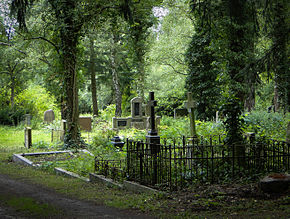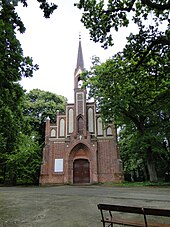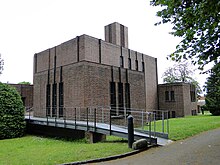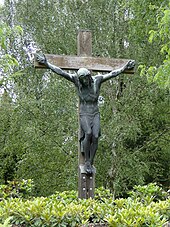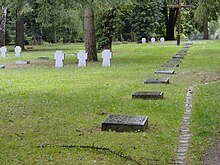Old Cemetery (Schwerin)
The old cemetery is a park cemetery in Schwerin . It is located on the southern Obotritenring in the Weststadt district and has an area of around 28 hectares.
history
During his town planning in 1862, the Schwerin court architect Georg Adolf Demmler selected the area on a hill on the former Galgenberg between Ostorfer See and Grimkesee as the location for today's Old Cemetery . The city's magistrate and the upper church council decided in 1862 to build the cemetery as a replacement for the cathedral cemetery. The grand ducal garden director Theodor Klett was commissioned with the design . The entrance to the new cemetery should be at the field gate, so the gatekeeper building there could be converted into a house for the gravedigger. Before that, the half-timbered building stood as a guardhouse on Spieltordamm. When Theodor Klett submitted his situation plan for the new Gottesacker on May 25, 1863 to the Upper Church Council in Schwerin, the paths had already been completed and the field stone ring wall completed.
On the afternoon of July 28, 1863, on the occasion of the first burial that took place there with a solemn procession, in which the magistrate and the citizens' committee also took part, the cemetery was opened by the superintendent Dr. Solemnly consecrated to Karsten.
The Schwerin cemetery is one of the early examples of a park cemetery in northern Germany, before the Hamburg-Ohlsdorf park cemetery , which was inaugurated in 1877 .
In addition to the special horticultural design, the network of paths, the trees and trees, it is the multitude of culturally and art-historically valuable gravestones and graves, which were mostly created between 1870 and 1940 and which particularly distinguish the monument value of the cemetery. This also includes the grave chapels and the cemetery chapel, which were integrated into the park landscape as structural highlights.
The first cemetery expansion took place in 1874. According to Theodor Klett's plans, the cemetery was enlarged in the north, south and west. There were also expansions in 1881, 1883, 1897 and 1916. With these expansions, the cemetery reached its current size of 28.1 hectares. All attempts by the Oberkirchenrat to get the city involved in the costs of the cemetery expansion failed for the time being. In 1917 the church even went into debt, the negotiations dragged on until 1922. On July 1, 1922, the cathedral ceded ownership of the old cemetery, which belonged to it, along with buildings and inventory, to the city of Schwerin for 1,273,485 marks. The handover took place on December 2nd and 4th, 1922.
Since the end of 1922, the city council concerned itself with its cemetery commission, whether the new office should be called cemetery administration or burial office .
With the opening of the new forest cemetery in the Krebsförden district in 1969, burials in the old cemetery only take place in existing family graves. According to the Graves Act, which is also valid in Mecklenburg-Western Pomerania, the repair of the war cemeteries and the redesign of the old cemetery began in 1991. In the coming years, the listed Old Cemetery is to develop into a park cemetery.
Church buildings
Gravedigger House
The former gatekeeper and guard house, a single - storey half-timbered building with a half- hipped roof , at the field gate was converted into a grave digger's house in 1866. To the east of this is the first cemetery entrance with the wrought-iron entrance gate made in 1866 by the Schweriner Eisengießerei und Maschinenfabrik. After several conversions and extensive renovations in 2007 and 2008, there is now a flower shop and a café.
Cemetery chapel
According to the cemetery regulations of 1864, confirmed by the Grand Ducal, the pastor and cantor led the funeral procession from the cemetery gate to the cemetery chapel, also known as the funeral chapel, while the school choir sang. The church builder and court building officer Theodor Krüger was responsible for the design and construction . The foundation stone of the neo-Gothic brick building took place on May 26, 1863. The consecration of the cemetery chapel was carried out on January 14, 1864 by Superintendent Karsten.
The west facade was given a four-tiered gable with a raised central portal and a bell tower . The slim tower with its four open pointed arched windows and the eight-sided pointed helmet has a ball, a weathercock and a cross as a crown . There is also a copper cross on the straight east gable with the brick cross and rose window. The main nave consists of four bays with stepped pillars and a gable roof with rectangular slate . The ogival double windows are provided with leaded diamond glass. In the pointed arch of the entrance door is the inscription: Jesus Christ - yesterday and today - and the same in eternity ( Hebrews 13.8 EU ). The interior fittings included a crucifix with a gilded body and four oil paintings.
The square surrounding the chapel was intended for the graves of the Schwerin clergy by order of the Upper Church Council. Regional bishops, provosts, church councilors and court preachers, but also court building officer Hermann Willebrand found their final resting place here.
Funerary chapels
Whoever wanted to build a burial chapel had to have the construction drawings approved by the Upper Church Council (OKR) in Schwerin. Between 1863 and 1915, 19 chapels were built by Schwerin citizens, four of which still exist.
Georg Adolf Demmler acquired the first place for a burial chapel on the southern terrace slope of the former Galgenberg on June 9, 1863 from the Schwerin church council, just one month before the official cemetery inauguration. His wife Henriette, who died on May 7, 1862 and was buried in the chapel wall in the cathedral cemetery, was transferred to the burial chapel built as a mausoleum in 1864. After his death on January 2, 1886, GA Demmler himself was buried in the chapel. The lowering of the coffins into the crypt took place in 1985 during emergency safety work. The small sandstone building with side terraces is richly decorated with neo-Romanesque and neo-Gothic decorative elements and Freemason motifs and is surrounded by twelve classifying bowls and marble reliefs. The marble medallions by Georg Adolf and Henriette Demmler on the back wall were created by the sculptor Ludwig Brunow . The burial chapel was extensively renovated in 2004 for the architect and freemason's 200th birthday and in 2006 for the 120th anniversary of his death. It is considered a gem of the Sepulchral Culture . Among the donors for the restoration and restoration of the Demmler Chapel are the Grand Lodge of the Freemasons from Germany to Berlin, the Grand Lodge Austria to Vienna and the lodges in Bremen, Kiel, Lübeck, Lüneburg, Schwerin and Stuttgart.
The second grave chapel in the old cemetery was built in 1864 by the Commissioner Mantinus as a member of the Mecklenburg government's department for city and police matters on the left side next to the Demmler grave chapel. The building drawings were made by court building officer Hermann Willebrand. Like most chapels, it was demolished in 1965 because it was in disrepair.
The ashlar plastered funerary chapel above the Demmler mausoleum from 1893 to this day (is being renovated in July 2014) belonged to Wilhelm Masius, whose family already had two chapels in the cathedral cemetery . In the neo-Gothic brick chapel at the beginning of the Kapellenweg, once used as an urn party room, there has been an art campaign by Otto Dressler since 2004.
In addition to the actual grave chapels, there is also the smaller form of the hillside tomb in the old cemetery. The brick burial site stretching into the slope, closed on the valley side with a grating, only had space for the coffins. A well-preserved hillside crypt from 1882 can be found on Untere Kapellenweg. To the right of it, behind shrubbery, there is still a partially collapsed chapel.
The crockery and workshed for the grave diggers, known as the blacksmith's shop on Kapellenweg and Kreuzweg, was built in 1863 based on designs by the court building councilor Theodor Krüger .
Mortuary with gravedigger's apartment
According to designs by the church builder and court building officer Theodor Krüger, a morgue was built in 1865 on today's Unteren Weg, at the corner of Talweg, to store the dead until burial. A section room for the jurisdiction of the Grand Ducal Office was also created, which the city of Schwerin was also allowed to use. For cost reasons, only a living space could be created for the gravedigger instead of an apartment. Hardly used after 1920, the morgue with the outbuildings was converted into apartments in 1928. Today the buildings are no longer used, apart from the extension on the left with the three garages. Windows and doors are nailed up, the leaded diamond glass windows in the gable are smashed and a terrace on the southern slope is attached with tombstones.
Crematorium and mourning hall
The Schwerin cemetery administration campaigned in 1925 to accelerate the development of a project to build a crematorium. In addition to the cremation facility, this should contain a mourning prayer hall and a morgue. In June 1929, the city planning officer, Andreas Hamann, presented a draft which was approved by the cemetery commission. The inauguration of the brick building, built in Bauhaus style, took place on December 14, 1930. The simple, high interior, clad with red bricks, is interrupted on the long walls as a contrast by the narrow, long purple, blue and yellow glazed windows.
The lawn opposite the crematorium was designed as a decorative area according to a plan from 1926. In 1945, war victims found a resting place in the northern part. After it was leveled in 1961 and a memorial for deserving fighters for democracy and socialism was built in 1965, the war cemetery was restored in 2005 with a large wooden symbol cross.
Cemetery of honor
The city council of Schwerin rejected the proposal to create an honorary cemetery on the Schelffriedhof for reasons of cost and implemented it from 1917 onwards in the old cemetery. In May 1916, the city architect, Ministerialbaurat Paul Ehmig , presented two drafts to the magistrate; Plan B was implemented from 1917. It was a square, enclosed by low walls, in the middle of which four pyramidal oaks were planted. The Rostock garden director Wilhelm Schomburg was consulted for horticultural issues. The arrangement of the area in the south of the cemetery with a view of the Grimkesee and the surrounding landscape had been carefully considered. The landscape preferred place was included in the design of the extension area of the cemetery.
The cemetery of honor was occupied quickly. In July 1917, Captain Eberstein applied for 50 graves to be buried for members of the Görries Aviation Observation School. The Rostock sculptor Walter Rammelt created the first memorial for the Ehrenfriedhof. In 1920 the square memorial stone with a crowning bowl, the reliefs of a warrior and a mourning woman as well as inscriptions typical of the time were erected.
The cemetery of honor was also provided with plantings by 1920 and in April 1924 the four pyramid oaks on the memorial were removed. The existing monument had been in poor condition since 1924. In 1926, the Schwerin architect and city planning officer Andreas Hamann presented a new design. The memorial, executed by the company C. Schäfer und Sohn, consisted of a brick base on which stood a sarcophagus decorated with four laurel wreaths. The inauguration took place on October 4, 1934. In 1935 work began on redesigning the cemetery of honor, which was completed in 1937. Now the focus on a wall was the soldier sculpture created in 1936 by the sculptor Wilhelm Wandschneider . The inauguration took place on June 6, 1937.
The area of the cemetery of honor, now known as the grave site of the First and Second World War , was retained in its design from 1937.
The grave field on Christ
The collective grave on Christ is located in the western cemetery area on Birkenweg. Behind the grave area is a hill on which the sculpture Christ on the Cross by the sculptor Hugo Berwald stands. He had created the sculpture in 1908 for his wife's grave, but had to sell it due to financial need. It came into the possession of the family of the Mecklenburg State Minister Count von Bassewitz-Levetzow and in 1928 the old cemetery. When the sculptor died in 1937, he was buried under the crucifix. Between 1945 and 1946, 294 German epidemic victims were buried in the grave area in front of it.
Grave fields for war dead of the Second World War
The former honorary cemetery in the south with individual graves and the grave field of Christ are war graves with distinctive designs. The old cemetery has other large, medium-sized and small war grave fields, which were much simpler when they were laid out between 1945 and 1946. This is certainly due to the large number of burials. All war cemeteries distributed over the entire cemetery area are of historical and cultural significance.
Among the buried are members of the Wehrmacht who died in various reserve hospitals in Schwerin, in the Görries air base , in the Buchholz, Moltke and Haselholz barracks and in camps. In addition to the military hospital in Wallstrasse, there were 30 other hospitals in Schwerin in 1945. These included the castle hospital , the Sachsenberg hospital, two hospitals on the Lewenberg and the reserve hospital in the Kurhaus am Bornberg in Zippendorf, which was confiscated by the Air Force in 1944 . The hospital in the castle was later used as an epidemic hospital for the civilian population. The registration of the war graves and the creation of the war grave lists with an inventory plan took place in the years 1990 to 1996 by the city garden authority, the SDS city economic services Schwerin.
It also includes the foreign war victims and the repatriation of foreign soldiers to their homeland from 1948 to 1949. In November 1950, the relocation of the graves of fallen foreign and German former members of the Wehrmacht outside of cemeteries was completed.
After 1961, some war cemetery fields were leveled without any comprehensible resolutions, but with a political background. The GDR had only recognized the four Geneva Conventions of 1949 and the resolution of the Red Cross Conference in 1965 at the end of 1970.
Memorial of the Socialists
The memorial for deserving fighters for democracy and socialism was built in 1965 on the Schmuckplatz opposite the crematorium. Before that, in 1961 the war grave field was leveled in the northern part and the jewelry area was redesigned on the instructions of the former SED district leadership in Schwerin. The grave field was leveled before the end of the statutory rest period of 25 years.
The memorial was built on the southern border of the grave field. A wall made of Main sandstone with the inscription From the ashes of our dead the new seeds germinate. was built. In the middle of the wall the bronze group of figures fighters for democracy and socialism was placed. It came from the Berlin sculptor and national prize winner of the GDR Hans Kies . The inauguration of the memorial took place in 1965. Prominent victims of Nazi persecution and anti-fascist resistance fighters found their final resting place in urn graves in front of the Wall. However, people were also named here who, according to the political understanding of the time, were among the fighters for democracy and socialism. The builder Georg Adolph Demmler was also on the nameplates of these people attached to the wall. The memorial was one of the largest in the Schwerin district at the time.
In 1991 it became known that war victims were buried in the green area around the memorial. After the memorial site was deleted from the list of monuments of the city of Schwerin in 1991 by resolution no. 331, the wall was demolished in 2004 as part of the restoration of the war cemetery. The plastic and name tablets were stored in the fund of the Folklore and City History Museum. The 54 urns were reburied in the cemetery of the victims of fascism and the forest cemetery.
Graves of famous personalities
- Johann Basedow (1830–1899), disabled pedagogue
- Robert Beltz (1854–1942), prehistorian
- Hugo Berwald (1863–1937), sculptor
- Frida von Bülow (1822-1894), Fritz Reuter's childhood sweetheart
- Claus Clauberg (1890–1963), composer
- Georg Daniel (1829–1913), architect, secret senior building officer
- Georg Adolph Demmler (1804–1886), architect, court building officer and socialist
- Otto Drewes (1845-1910), German opera singer (bass)
- Paul Ehmig (1874–1938), architect and construction director
- Carl Friedrich Flemming (1799-1880), psychiatrist
- Hans Franck (1879–1964), writer and dramaturge
- Heinrich Friese (1860–1948), biologist and entomologist
- Rudolf Gahlbeck (1895–1972), painter, graphic artist, art educator and author
- Andreas Hamann (1884–1955), government master builder and city planner
- Karl Hennemann (1884–1972), painter, graphic artist and wood cutter
- Carl Hinrichs (1903–1990), painter
- Eduard Hobein (1817–1882), writer
- Eduard Huben (1847–1912), shipowner
- Rudolph Karstadt (1856–1944), department store entrepreneur
- Theodor Kliefoth (1810–1895), theologian and church reformer
- Bertha Klingberg (1898–2005), flower maker and honorary citizen of the city of Schwerin
- Friedrich Wilhelm Kücken (1810–1882), composer
- Hans Heinrich Leopoldi (1917–1978), city archivist
- Georg Christian Friedrich Lisch (1801–1883), archivist and publicist
- Reinhold Lobedanz (1880–1955), GDR politician (GDR CDU)
- Konrad von Loeben (1852–1911), major general
- Adolf Friedrich Lorenz (1884–1962), monument conservator and architect
- Ernst Lübbert (1879–1915), painter and illustrator
- Friedrich von der Lühe (1846–1924), major general and court marshal
- Carl Malchin (1838–1923), landscape painter
- Kurt Maltner (1886–1965), painter
- Otto Metterhausen (1861–1943), President of the State Parliament
- Clemens Meyer (1868–1958), musician, composer and musicologist
- Heinrich Mußfeldt (1882–1958), architect
- Friedrich Paschen (1804–1873), lawyer, geodesist and astronomer
- Heinrich Petters (1810–1884), sculptor
- Friedrich Wilhelm von Rauch (1827–1907), Lieutenant General (grave was lost in the bombing of Schwerin in April 1945)
- Horst Rehberg (1937–2018), theater and film actor
- Walter Romberg (1928–2014), politician (GDR finance minister)
- Adam Scharrer (1889–1948), writer
- Friedrich Schlie (1839–1902), archaeologist and art historian
- Theodor Schloepke (1812–1878), painter
- Karl Schöning (1855–1928), Low German writer
- Gustav Schwantz (1888–1964), local politician, SED functionary and Lord Mayor of Schwerin
- Richard Spethmann (1891–1960), actor
- Guido von Usedom (1854–1925), admiral
- Konrad von Warnstedt (1875–1918), killed as a lieutenant colonel and regimental commander
- Friedrich Carl Wex (1801–1865), classical philologist and director of the Fridericianum in Schwerin
- Hermann Willebrand (1816–1899), architect
Monument protection
In December 1980, individual graves and the Demmler Chapel were placed under monument protection. In 1988, the then Institute for Monument Preservation at the City Council of Schwerin recommended that the old cemetery in its historical basic structure be placed under monument protection as a garden and landscape monument. This status was recorded in the list of monuments of the city of Schwerin from July 28, 1994.
swell
- State Church Archive Schwerin
- LKAS OKR, Specialia Schwerin
- Architectural drawings and plans for church cemetery buildings
-
State Main Archive Schwerin
- LHAS 5.12-7 / 1 Mecklenburg-Schwerin Ministry for Education, Art, Spiritual and Medical Matters . No. 8668 Creation of a new cemetery in 1864.
- LHAS 6.11-18 Ministry of Finance . No. 35472 Schwerin cemetery administration from 1949.
-
Schwerin City Archives
- Cemetery administration
- City Building Office
- magistrate
- Lord Mayor, only contains complaint about desecration of graves and cemeteries by Russian occupation troops 1945–1946
- State Office for Culture and Monument Preservation
- LAKD, Dept. of Archeology and Monument Preservation
literature
- Karl-Heinz Oldag: Unforgotten - we still know your names - A walk through the old Schwerin cemetery , Stock & Stein, Schwerin 1995, ISBN 3-910179-48-7 .
- Birgid Holz: Schwerin old cemetery . In: Historical cemeteries in Germany. Publisher Bund Heimat und Umwelt in Germany. Bonn 2007, ISBN 978-3-925374-77-7 . Pp. 102-103.
- Katja Pawlak: Military cemeteries and war cemeteries in the state capital Schwerin. Schwerin 2012, ISBN 978-3-9813709-1-1 .
- Anja Kretschmer: Houses of Eternity. Mausoleums and burial chapels from the 19th century. Hamburg 2012, ISBN 978-3-934632-47-9 .
- Christine Rehberg-Crede, Matthias Proske: 150 years old Schwerin cemetery, 1863–2013, from the church to the garden monument. Schwerin 2013, ISBN 978-3-941689-15-2 .
Web links
- Literature about the old cemetery (Schwerin) in the state bibliography MV
- Cemetery plan
- Friends of the Alter Friedhof e. V. with pictures
Individual evidence
- ↑ StAS Magistrate No. 2988.
- ↑ LKAS OKR, No. 222.
- ↑ LKAS OKR, No. 222, StAS Magistrat No. 2989.
- ↑ LHAS 5.12-7 / 1 No. 8668.
- ↑ LKAS OKR, No. 236.
- ↑ LKAS OKR, No. 236.
- ↑ LKAS OKR, No. 236.
- ↑ LKAS OKR, No. 236.
- ↑ LKAS OKR, No. 222–226.
- ↑ Chronicle of the Schelfkirche, Volume 1, p. 35. … In 1813 the last execution was carried out on Galgenberg.
- ↑ LKAS OKR, No. 222.
- ↑ Historical graves - old cemetery ( Memento of the original from September 24, 2015 in the Internet Archive ) Info: The archive link was inserted automatically and has not yet been checked. Please check the original and archive link according to the instructions and then remove this notice.
- ↑ Anja Kretschmer: Mausoleums and burial chapels. 2012, pp. 45, 46.
- ↑ LKAS OKR, No. 236.
- ↑ StAS Magistrate No. 2477.
- ↑ LHAS 5.12-7 / 1 No. 8668.
- ↑ Burkhard Stender: Last rest for pioneers of modern building. Mecklenburg-Magazin, regional supplement of the SVZ, January 22nd, 20 ^ 6, s. 24.
- ↑ StAS City Building Office No. 2367.
- ↑ LKAS OKR, Schwerin local files, Kirchhof No. 230.
- ↑ Katja Pawlak; The cemetery of honor in the old cemetery in Schwerin. In: The preservation of monuments. 2014, issue 1, pp. 63–64.
- ↑ LKAS OKR, Schwerin local files, Kirchhof No. 230.
- ↑ Katja Pawlak: The cemetery of honor on the old cemetery in Schwerin. In: The preservation of monuments. 2014, issue 1, p. 64.
- ↑ Katja Pawlak: The redesign of the cemetery of honor until 1937. In: Military cemeteries and war graves in the state capital Schwerin. Schwerin 2012 pp. 27–30.
- ↑ Katja Pawlak: The grave field on Christ. In: Military cemeteries and war cemeteries in the state capital Schwerin. Schwerin 2012, pp. 30–33.
- ↑ Katja Pawlak: Grave fields for war dead in World War II . In: Military cemeteries and war cemeteries in the state capital Schwerin. Schwerin 2012, pp. 31-38.
- ↑ LHAS 6.11-11 Ministry of the Interior, No. 1802, 1803 Friedhöfe, General 1946–1952.
- ↑ LaKD, files to the Old Cemetery, wallet 1 (1926-1990).
- ↑ Katja Pawlak: The memorial of the socialists. In: Military cemeteries and war cemeteries in the state capital Schwerin. Schwerin 2012, p. 39.
- ↑ LaKD, files to the Old Cemetery, portfolio 2 (1991-2001).
Coordinates: 53 ° 37 ′ 21.6 " N , 11 ° 23 ′ 56.7" E
